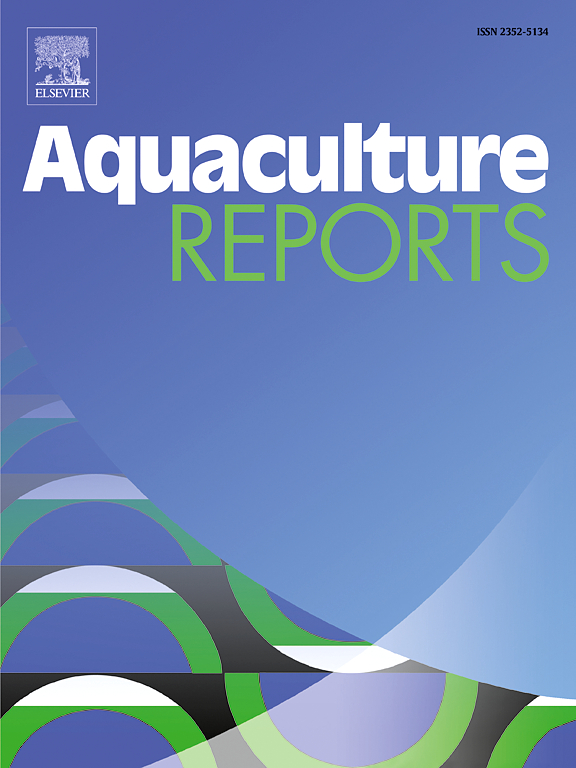Growth, serum biochemical, digestive enzyme activities, antioxidant, lipid metabolism and inflammation responses of juvenile hybrid snakehead (Channa maculata♀× Channa argus♂) fed diets with different dietary lipid levels
IF 3.2
2区 农林科学
Q1 FISHERIES
引用次数: 0
Abstract
The study investigated the effects of different dietary lipid levels on the growth, serum biochemical, digestive enzyme activities, antioxidant, lipid metabolism and inflammation responses of juvenile hybrid snakehead (Channa maculata♀×Channa argus♂). Six different dietary lipid levels (4.70 %, 6.25 %, 8.10 %, 10.35 %, 12.28 %, 14.39 %, labeled as L4, L6, L8, L10, L12, and L14) were prepared as equal protein feed for the experiment. 540 juvenile hybrid snakehead was selected for 63-day culture experiment with an initial weight of (5.31 ± 0.01) g and randomly divided into 6 groups. The results indicated that when the dietary lipid levels ranged from 4.70 % to 10.35 %, the weight gain rate (WGR), specific growth rate (SGR), and protein efficiency ratio (PER) of juvenile hybrid snakehead were significantly increased, while the feed conversion ratio (FCR) was significantly decreased (P < 0.05). The condition factor (CF), and visceral somatic index (VSI) of the fish showed an upward trend. The crude lipid of juvenile hybrid snakehead was significantly increased, while crude protein and moisture was showed the opposite change(P < 0.05). The serum levels of plasma cholesterol (CHOL) and high-density lipoprotein cholesterol (HDL-C) were significantly higher than the L14 group compared to the other groups(P < 0.05). There was no significant effect on alanine aminotransferase(ALT), aspartate aminotransferase (AST), total protein (TP), triglyceride (TG), low-density lipoprotein cholesterol (LDL-C), and LDL-C/HDL-C (p > 0.05). The ALT in the L14 and L12 groups were significantly higher than the L4, L6, and L8 groups, and the glutathione peroxidase (GSH-Px) of the L12 group was significantly higher than the other groups (P < 0.05). There was no significant effect on liver glycogen, AST, superoxide dismutase (SOD), malondialdehyde (MDA), catalase (CAT), and total antioxidant capacity (T-AOC) (P > 0.05). Furthermore, the expression levels of the mammalian target of rapamycin (mTOR) and acetyl-CoA carboxylase (ACC) in the liver first decreased and then increased, while the peroxisome proliferator-activated receptor α (PPARα) showed the opposite phenomenon(P < 0.05). There was no significant difference in the fatty acid synthase (FAS) (P > 0.05). The expression of the inhibitory subunit of nuclear factor-kappa B alpha (IκBα) in the L4 and L10 groups were higher than those in the L14 group, while the tumor necrosis factor-α (TNF-α) and interleukin-8 (IL-8) in the L6 group were significantly lower than those in the L4 group, and the interleukin-10 (IL-10) showed the opposite change(P < 0.05). The expression of interleukin-1β (IL-1β) in the L6 group was significantly higher than that in the L12 group (P < 0.05). In summary, considering the overall situation, the optimal dietary lipid requirements for juvenile hybrid snakehead is in the ranges of 10.17 % - 11.79 %.
不同饲粮脂肪水平对杂交蛇头幼鱼生长、血清生化、消化酶活性、抗氧化、脂质代谢和炎症反应的影响
本试验研究了不同饲料脂肪水平对杂交蛇头幼鱼(Channa maculata♀×Channa argus♂)生长、血清生化、消化酶活性、抗氧化、脂质代谢和炎症反应的影响。配制6种不同脂肪水平(4.70 %、6.25 %、8.10 %、10.35 %、12.28 %、14.39 %,分别标记为L4、L6、L8、L10、L12、L14)的蛋白质饲料。选取初始体重为(5.31 ± 0.01)g的杂交蛇头幼鱼540尾,随机分为6组,进行为期63 d的培养试验。结果表明,饲料脂肪水平在4.70 % ~ 10.35 %范围内,杂交蛇头幼鱼的增重率(WGR)、特定生长率(SGR)和蛋白质效率(PER)显著提高,饲料系数(FCR)显著降低(P <; 0.05)。条件因子(CF)和内脏体指数(VSI)呈上升趋势。杂交蛇头幼鱼的粗脂肪含量显著升高,粗蛋白质和水分含量变化相反(P <; 0.05)。血清血浆胆固醇(CHOL)和高密度脂蛋白胆固醇(HDL-C)水平显著高于L14组(P <; 0.05)。对丙氨酸转氨酶(ALT)、天冬氨酸转氨酶(AST)、总蛋白(TP)、甘油三酯(TG)、低密度脂蛋白胆固醇(LDL-C)和LDL-C/HDL-C无显著影响(p >; 0.05)。L14、L12组的ALT显著高于L4、L6、L8组,L12组的谷胱甘肽过氧化物酶(GSH-Px)显著高于其他各组(P <; 0.05)。对肝糖原、AST、超氧化物歧化酶(SOD)、丙二醛(MDA)、过氧化氢酶(CAT)和总抗氧化能力(T-AOC)无显著影响(P >; 0.05)。哺乳动物肝脏中雷帕霉素靶蛋白(mTOR)和乙酰辅酶a羧化酶(ACC)表达量先降低后升高,而过氧化物酶体增殖物激活受体α (PPARα)表达量则相反(P <; 0.05)。脂肪酸合成酶(FAS)差异无统计学意义(P >; 0.05)。核因子κBα抑制亚基(IκBα)在L4和L10组的表达均高于L14组,而肿瘤坏死因子-α (TNF-α)和白细胞介素-8 (IL-8)在L6组的表达均显著低于L4组,白细胞介素-10 (IL-10)的表达变化则相反(P <; 0.05)。白细胞介素-1β (IL-1β)在L6组的表达显著高于L12组(P <; 0.05)。综上所述,综合考虑整体情况,杂交蛇头幼鱼适宜的饲料脂肪需取量为10.17 % ~ 11.79 %。
本文章由计算机程序翻译,如有差异,请以英文原文为准。
求助全文
约1分钟内获得全文
求助全文
来源期刊

Aquaculture Reports
Agricultural and Biological Sciences-Animal Science and Zoology
CiteScore
5.90
自引率
8.10%
发文量
469
审稿时长
77 days
期刊介绍:
Aquaculture Reports will publish original research papers and reviews documenting outstanding science with a regional context and focus, answering the need for high quality information on novel species, systems and regions in emerging areas of aquaculture research and development, such as integrated multi-trophic aquaculture, urban aquaculture, ornamental, unfed aquaculture, offshore aquaculture and others. Papers having industry research as priority and encompassing product development research or current industry practice are encouraged.
 求助内容:
求助内容: 应助结果提醒方式:
应助结果提醒方式:


